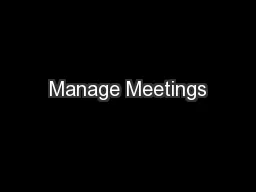

Best practice for meeting procedures Prepare for meetings Conduct meetings Followup meetings Do Meetings Matter Why do you think you attend meetings By attending a meeting you have the chance to have your say in what goes on at your club ID: 340431
Download Presentation The PPT/PDF document "Manage Meetings" is the property of its rightful owner. Permission is granted to download and print the materials on this web site for personal, non-commercial use only, and to display it on your personal computer provided you do not modify the materials and that you retain all copyright notices contained in the materials. By downloading content from our website, you accept the terms of this agreement.
Slide1
Manage Meetings Slide2
Best practice for meeting procedures
Prepare for meetings
Conduct meetingsFollow-up meetingsSlide3
Do Meetings Matter?
Why do you think you attend meetings?
By attending a meeting you have the chance to have your say in what goes on at your club. Do you think meetings waste your time? Meetings do take up your time however without a means of communication a club can not function. Who should attend a meeting? Any financial member of a club may attend a member however the Associations constitution states that you must be 18 years of age to vote. Slide4
Types of Meetings
There are only a few types of meetings at
Pony ClubGeneral Meeting (usually monthly), Annual General Meeting (AGM) and Special General MeetingManagement or Executive Committee meetingsSub committee meetingsInformation sessionsSlide5
Planning for Meetings
Venue – Ensure it is suitable for the number attending.
Seating – Ensure that there are enough seats for everyone. Time-frames – Have a time-frame in mind don’t let the meeting drag on all night. Info to be presented and how? – Do you need handouts?How you inform attendees – Via hard copy agenda, email agenda?Specific roles of attendees – Who is responsible for what job?Slide6
Successful Meetings
Start on time
Pre-distribute the agendaTimeframes attached to agenda itemsFocus on objectivesChaired by elected person who clarifies and avoids unnecessary debateAccept apologies for those un-attendeesKept on track by chairpersonResults orientedEnd on time and on a positive noteMinutes are distributed in a timely manner with items to be actionedSlide7
Agenda
Statement of the meetings purpose
Date, time, place, and locationWelcomeMinutes of the previous meetingMatters of business arriving from previous meetingCorrespondenceReportsMajor agenda itemsGeneral businessDates of next meetingSlide8
AgendaSlide9
At the Meeting
Call to order
MinutesBusiness ArisingOfficer’s reportsCommittee reportsNew businessesSpecial interest programsAnnouncementsAdjournmentSlide10
Meeting Protocol
The style and structure of any meeting will depend on:
Its purpose – is this a monthly meeting to keep members up to date or is it an AGM.The number of participants – do you require a larger meeting room for an AGMSpecial needs of participants Slide11
Meeting Protocol
Steps to ensure meeting appropriate protocol:
Make a list of all people who are expected to attendWhat timeframes are involvedWhat formalities are involvedEnsure all members are aware that the meeting is scheduled. Slide12
Meeting Confirmation
It’s a good idea to confirm any bookings e.g. venue, equipment etc. a few days prior to prevent mishaps on the day.Slide13
Conducting Meetings
Roles within meetings:
Chairperson – what is his/her role? A Chairperson should be well respected and have control of the meeting at all times, they should also be impartial and keep any personal opinions out of the meeting. The Chairperson should steer the meeting through an Agenda and limit the time that speakers have so that the meeting can finish on time. Recorder (minute taker) – what is his/her role? – A minute taker should confer with the Chairperson to ensure that they know what details need to be recorded. They should keep an accurate record of the meeting and follow the agenda where possible. Slide14
Conducting Meetings
Participants – what is their role? – Should always be respectful of other participants and observe meeting protocol of either standing or raising their hands if they wish to speak and always speak through the chair. Slide15
Conducting Meetings
What can be done if a meeting deviates from its planned agenda? If the meeting is deviating from the planned agenda the Chair should guide the meeting back to the correct topic.
Who do you think should chair meetings – why? – A Chairperson should be capable of guiding a meeting and keeping things under control. How long should meetings last – why? Meetings should be kept to as short a time as possible, it is easier to get a consensus if people are focused and not bored. It is better to have more frequent meetings than really long meetings. How can you encourage participation in meetings? The Chairperson should remind people that they are part of the meeting process and encourage input. Slide16
Recording Minutes
Accurate recording is essential:
Provides a transcript of the meetingProvides accurate record of what has been said by whomAllows people to review what they said and committed toCan be referred to in any disputesInforms those members who couldn’t attendUsed to check progress toward completion of actionable itemsSlide17
Recording Minutes
Minutes should include:Items for discussion
DecisionsActionsTimelinesPersons responsible for actionsSlide18
MinutesSlide19
Follow-up Meetings
Before distributing minutes, check for:
Suitability of tone and communication style with the ChairpersonReadability, grammar, spelling, etc.Sequencing and structureOrganisational requirementsDiscriminatory languageJargon that may not be understood by all.Slide20
Conclusion:
Prepare for meetings – preparation and notifications of meetings is essential to good communication within a club.
Conduct meetings – make sure that meetings are professionally run and that all participants have a chance to have their say. Ensure that the meeting keeps to the agenda and runs to projected time frames. Follow-up meetings – it is essential that all actionable items are attended to as soon as possible and followed up before the next meeting.